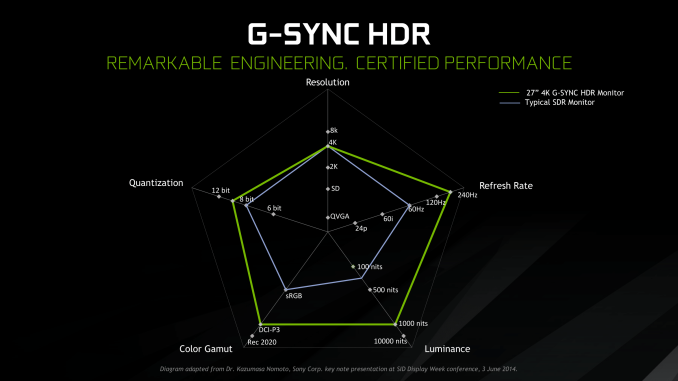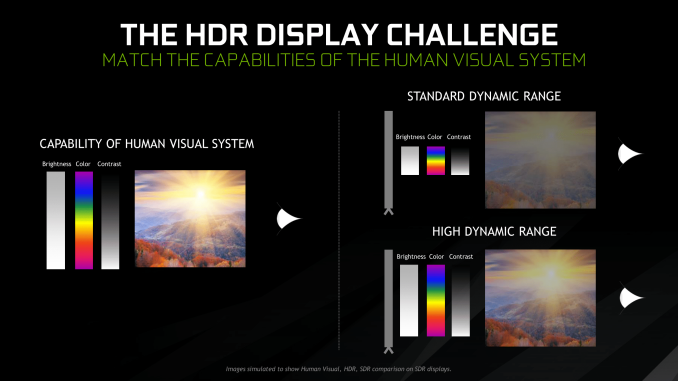The NVIDIA GeForce RTX 2080 Ti & RTX 2080 Founders Edition Review: Foundations For A Ray Traced Future
by Nate Oh on September 19, 2018 5:15 PM EST- Posted in
- GPUs
- Raytrace
- GeForce
- NVIDIA
- DirectX Raytracing
- Turing
- GeForce RTX
Meet The New Future of Gaming: Different Than The Old One
Up until last month, NVIDIA had been pushing a different, more conventional future for gaming and video cards, perhaps best exemplified by their recent launch of 27-in 4K G-Sync HDR monitors, courtesy of Asus and Acer. The specifications and display represented – and still represents – the aspired capabilities of PC gaming graphics: 4K resolution, 144 Hz refresh rate with G-Sync variable refresh, and high-quality HDR. The future was maxing out graphics settings on a game with high visual fidelity, enabling HDR, and rendering at 4K with triple-digit average framerate on a large screen. That target was not achievable by current performance, at least, certainly not by single-GPU cards. In the past, multi-GPU configurations were a stronger option provided that stuttering was not an issue, but recent years have seen both AMD and NVIDIA take a step back from CrossFireX and SLI, respectively.
Particularly with HDR, NVIDIA expressed a qualitative rather than quantitative enhancement in the gaming experience. Faster framerates and higher resolutions were more known quantities, easily demoed and with more intuitive benefits – though in the past there was the perception of 30fps as cinematic, and currently 1080p still remains stubbornly popular – where higher resolution means more possibility for details, higher even framerates meant smoother gameplay and video. Variable refresh rate technology soon followed, resolving the screen-tearing/V-Sync input lag dilemma, though again it took time to catch on to where it is now – nigh mandatory for a higher-end gaming monitor.
For gaming displays, HDR was substantively different than adding graphical details or allowing smoother gameplay and playback, because it meant a new dimension of ‘more possible colors’ and ‘brighter whites and darker blacks’ to gaming. Because HDR capability required support from the entire graphical chain, as well as high-quality HDR monitor and content to fully take advantage, it was harder to showcase. Added to the other aspects of high-end gaming graphics and pending the further development of VR, this was the future on the horizon for GPUs.
But today NVIDIA is switching gears, going to the fundamental way computer graphics are modelled in games today. Of the more realistic rendering processes, light can be emulated as rays that emit from their respective sources, but computing even a subset of the number of rays and their interactions (reflection, refraction, etc.) in a bounded space is so intensive that real time rendering was impossible. But to get the performance needed to render in real time, rasterization essentially boils down 3D objects as 2D representations to simplify the computations, significantly faking the behavior of light.
It’s on real time ray tracing that NVIDIA is staking its claim with GeForce RTX and Turing’s RT Cores. Covered more in-depth in our architecture article, NVIDIA’s real time ray tracing implementation takes all the shortcuts it can get, incorporating select real time ray tracing effects with significant denoising but keeping rasterization for everything else. Unfortunately, this hybrid rendering isn’t orthogonal to the previous concepts. Now, the ultimate experience would be hybrid rendered 4K with HDR support at high, steady, and variable framerates, though GPUs didn’t have enough performance to get to that point under traditional rasterization.
There’s a still a performance cost incurred with real time ray tracing effects, except right now only NVIDIA and developers have a clear idea of what it is. What we can say is that utilizing real time ray tracing effects in games may require sacrificing some or all three of high resolution, ultra high framerates, and HDR. HDR is limited by game support more than anything else. But the first two have arguably minimum performance standards when it comes to modern high-end gaming on PC – anything under 1080p is completely unpalatable, and anything under 30fps or more realistically 45 to 60fps hurts the playability. Variable refresh rate can mitigate the latter and framedrops are temporary, but low resolution is forever.
Ultimately, the real time ray tracing support needs to be implemented by developers via a supporting API like DXR – and many have been working hard on doing so – but currently there is no public timeline of application support for real time ray tracing, Tensor Core accelerated AI features, and Turing advanced shading. The list of games with support for Turing features - collectively called the RTX platform - will be available and updated on NVIDIA's site.













337 Comments
View All Comments
ESR323 - Wednesday, September 19, 2018 - link
I agree with the conclusion that these cards aren't a good buy for 1080ti owners. My 1080ti overclocks very nicely and I'll be happy to stick with it until the next generation in 7 nm. By then we might have a decent selection of games that make use of ray tracing and the performance increase will be more appealing.imaheadcase - Wednesday, September 19, 2018 - link
Yah i agree, especially its only a 20-25fps increase on average. While many might thing thats great, considering the price increase over 1080TI and the fact many 1080TI can overclock to close that gap even more. The features don't justify the cost.However, it could be lots of performance could be unlocked via driver updates..we really don't know how tensor cores could increase performance till the games get updated to use it. Also, while super expensive option...how does the new SLI performance increase performance? Lets see a compare from 1080TI sli to newer sli 2080TI..maybe its easier to put into games? So many what-ifs with this product.
I feel this product should of been delayed till more games/software already had feature sets available to see.
Aybi - Thursday, September 20, 2018 - link
There wont be driver&optimization support for 1000 series. They will focus on 2000 series and with that the gap going to increase a lot.If you remember 980ti and 1080ti it was the same case when 1080ti announced and then you know what happened.
Vayra - Friday, September 21, 2018 - link
Actually I don't and there is also no data to back up what you're saying. The 980ti still competes with the 1070 as it did at Pascal launch.Don't spread BS
Matthmaroo - Sunday, September 23, 2018 - link
Dude that’s not true at allNvidia will fully support the 10 series for the next 5 -10 years
They all use the same CUDA cores
Don’t just make crap up to justify your purchase
SanX - Thursday, September 20, 2018 - link
What the useless job the reviewer is doing comparing only to latest generstion cards? Add at least 980Ti and 780TiMrSpadge - Thursday, September 20, 2018 - link
Ever heard of their benchmark database?Ryan Smith - Thursday, September 20, 2018 - link
You'll be glad to hear then that we'll be backfilling cards.There was a very limited amount of time ahead of this review, and we thought it to be more important to focus on things like clocking the cards at their actual reference clocks (rather than NVIDIA's factory overclocks).
dad_at - Sunday, September 23, 2018 - link
Many thanks for that, I think it is useful job, people are still using maxwell(or even older) generation GPU in 2018. And when we could expect maxwell (980/980ti) results to appear in GPU 2018 bench? Could you also please add Geforce GTX Titan X (maxwell) to GPU 2018?StevoLincolnite - Sunday, September 23, 2018 - link
Hopefully you back-fill a substantial amount, the GPU bench this year has been a bit lacking... Especially in regards to mid-range and older parts.Whole point of it is so that you can see how the latest and greatest compare it to your old and crusty.